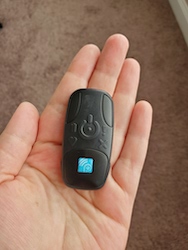Wearing a Heart Monitor for a Week
Lupus can go after any part of the body; it’s notorious for going after the kidneys. But in many cases, it affects the heart. Lupus can cause a wide range of heart issues and can double or triple your risk of heart attacks, heart failure, and cardiovascular disease.1
When I brought up possible signs of heart issues, my doctor was quick to order a monitor. While my symptoms could have been chalked up to anxiety, it's best not to take any chances regarding lupus and heart health. Even if we just ruled something out, I needed to know for certain. I'm thankful my doctor had the same point of view - sometimes, it's hard to get medical professionals to be proactive and take people seriously.
Getting my heart monitor
I thought I would go to a cardiologist’s office to have a Holder monitor placed. Then, the office called to let me know they would be using a mini Holder monitor that could be mailed to me. I was surprised and happy that I didn't have to figure out childcare for another appointment.

A few days later I received a small box that contained the monitor, a charger, strips for attaching the monitor, saline wipes, instructions, and paperwork to fill out for any symptoms I experienced while wearing the monitor. It was small enough to fit in the palm of my hand.
I was a little skeptical but also relieved that I didn’t have to be hooked up to a larger monitor or have EKG leads that my kids would inevitably want to play with. Instead, I easily and discretely applied the monitor; it wasn’t visible underneath a normal crew neck shirt or sweatshirt.
7 days with a heart monitor
The process was pretty simple. I cleaned my skin, applied the heart monitor, and made sure it was turned on correctly. Then, I pushed the button whenever I experienced noteworthy symptoms. The symptom list included rapid heartbeat, lightheadedness, fluttering sensations, faintness, chest pain or tightness, tiredness, and shortness of breath. If I felt these things, I pushed the button and then noted the time, the specific symptom, and what I was doing, such as exercising, walking, sitting, or eating.
This neat little monitor was waterproof and submersible up to 3 feet, but I didn’t feel comfortable bathing while wearing it. However, I did spill some drinking water on it once and nearly spilled coffee on it.
When I showered, I would remove it, charge it, and then reapply it with a new adhesive strip. The first time I removed the monitor, I noticed a little skin irritation. By the end of the week, my skin was red and felt raw from the strong adhesive used to hold the monitor firmly in place.
I’m glad the test lasted 7 days because I’m not sure I could have worn it for much longer without becoming quite irritable. Around day 5 it started to itch and generally get on my nerves. But I would have worried that we might have missed something if we had done a 3-day test.
The heart monitor was easy to hide
Occasionally the monitor was visible during the week, but only 2 adults noticed and asked about my monitor while I was out and about. I did preschool drop-offs, went shopping, and I went to an event at my son’s elementary school without people noticing or saying anything. It was nice that it was small and unobtrusive, unlike what I had imagined I’d have with a full-size Holder monitor.
Of course, my young boys noticed and very much wanted to push the button, but thankfully it was easy to distract them. Doing this test in the fall season was nice because I didn’t sweat much as I tend to in summer, which could cause more irritation. I also wore a sweatshirt most days that covered it up but still allowed me to access it if needed.
My anxiety continued to ask, was it working? How powerful was this miniature monitor? According to the manufacturer, it can store data for 30 days.2 I was anxious to see my data.
My heart monitor results
It took a little over a week to get my test results after I returned the heart monitor via mail. The data review noted that I had fast and slow heartbeats and some abnormalities, but these were within the normal range. I had two premature ventricular contractions (PVC) during the 7 days I wore the monitor.
A PVC happens when the electrical signal that starts your heartbeat comes from a different spot, and it happens too early, causing an extra beat, fluttering sensations, and an irregular heartbeat. Since I only had 2 of them out of the approximately 700,000 heartbeats recorded, my incidence (or burden) was <0.01 percent. Overall that is good news. I am glad there’s nothing terribly wrong. However, I take medication that can lower my PVC rate, and I have hypertension. I wonder if the medication is keeping the PVC events in check. I will ask for ongoing and possibly additional heart monitoring so that we can catch anything that might go wrong early enough to take action.
I’m glad I wore the heart monitor for a week, have the data to know that things are stable right now, and be more aware of what kind of complications and symptoms to watch.
Do you have concerns about your heart health?

Join the conversation